“We’re at the beginning of a golden age of AI. Recent advancements have already led to invention that previously lived in the realm of science fiction – and we’ve only scratched the surface of what’s possible.”
– Amazon CEO, Jeff Bezos, at his public conference on Artificial Intelligence (2022).
During the last few years, Machine Learning (ML) and Artificial Intelligence (AI) have played an increasingly vital role in improving all aspects of how we operate as a society. With the massive advancement in hardware, especially in the automation realm, the ability to analyse data produced from increasingly powerful AI/ML algorithms, has become paramount.
Put simply, AI is shaping our future.
Meanwhile, the planet is in crisis. Our environment is changing at an unprecedented rate. Extreme climate change events have become the norm. Already, 2022 has brought with it powerful floods, terrifying wildfires, and unusually early heat waves. Freak hailstorms have battered Germany and Mexico City, and US forecasters expect an above-normal hurricane season.
How useful will the rise of Artificial Intelligence be for pursuing sustainability? Does it offer tools to help combat the catastrophic problem of climate change?
What is Artificial Intelligence (and Machine Learning)?
Artificial Intelligence refers to the ability of any machine or computer to mimic human capabilities. This includes learning from examples and experience, recognising objects, understanding, and responding to language, making decisions, and solving problems. Specific applications of AI include machine vision, expert systems, natural language processing (NLP), and speech recognition.
While Machine Learning is a subset of AI, it focuses on allowing computers to learn without being explicitly programmed. It is based on computational learning, using algorithms to learn from and make predictions on data. A subcategory of Machine Learning, called Deep Learning (DL), is inspired by the structure of the human brain (neural network).
ML and DL, process large volumes of data. They transform it into valuable information. This builds predictive and insightful intelligence, helping to make analysis and decision-making easier in complex situations like those presented by the climate crisis. Modeling is a safe way to address many of the wicked problems we face at arm’s length before they become disastrous effects. The application of such algorithms ranges from the processing of qualitative data (classification) and quantitative data (regression) to speech/writing – as well as image processing.
What is sustainability?
In 2015, the United Nations General Assembly agreed on 17 Sustainable Development Goals (SDGs). These goals were to resolve major global challenges, including poverty, hunger, inequality, climate change, and health. The intention was to achieve all of these by 2030.
Sustainability is the measure of something’s ability to continue to operate. The more sustainable something is, the longer it can continue. Currently, humanity’s trajectory on planet Earth is unsustainable. Therefore, the UN identified 17 Sustainable Development Goals (SDGs) which form the blueprint for a more sustainable future. These can be grouped under three pillars: Environment, Economy, and Society.
The SDGs recognise that there is an urgent need to build economic growth, improve education and health, and reduce inequality. At the same time they recognise the need to tackle the global issue of climate change. In addition, we must work to maintain and sustain our oceans and forests. The goals focus on transforming the world by providing a shared blueprint for peace and prosperity, and a plan of action or global collaborative partnership.
The SDGs are understood to be interdependent. A conception best illustrated by the wedding cake model by Stockholm Resilience Centre science director, Carl Folke, and others, in the diagram below.
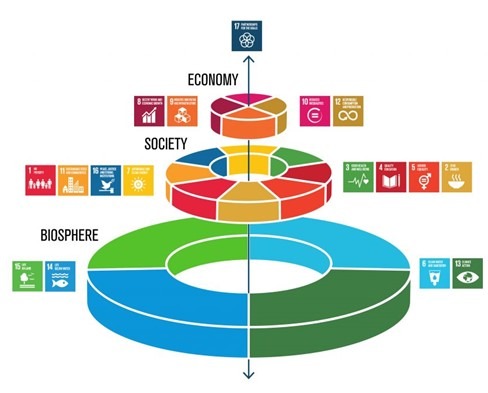
toward sustainability with the help of Artificial Intelligence
What has been made clear is that “A business-as-usual approach is not sustainable” (Bocken, 2014). However, there are several obstacles facing organisations wishing to transition to more sustainable outcomes.
The best place to start is to picture the society we would like. Next, we must devise plans that lead us towards it. Technically, this is known as backcasting. That means defining the future we seek and working backwards to the present, then setting milestones to be met along the way.
This activity embraces ‘a strive to thrive philosophy’. With regard to the global crisis, changes are required at a scale, speed and scope not seen before. In order for society to become more sustainable, we need a business strategy that addresses the three pillars of sustainability: economic, social and environmental.
Society is pressuring business leaders to look beyond creating shareholder value. People want companies to generate value for the environment and for society as well. After all, long-term financial gain is only possible through sustainable development. Both start-ups and established businesses need to embrace Sustainable Business Models (SBM) within the fabric of their organisation. It’s the only way to ensure long-term survival.
So, what do SBMs look like?
what is a sustainable business model?
A sustainable business is one that takes a holistic approach. No business operates in isolation; it exists within an ecosystem. At the very least, it relies upon a supply chain and a delivery chain. The sustainable value model shows how an organisation creates value from this ecosystem. To continue generating value from the environment, an organisation must calculate its effects on the environment (Evans, Steve, et al., 2009).
Sustainable business models can therefore be described as complete or holistic business models. SBMs have evolved to include external stakeholders, such as society and the environment. This changes the calculation of any value creation model. A company must include the full impact of business practices on external stakeholders to determine the net value it produces.
As a result, many questions arise. For example, how can an organisation calculate its effects on the environment? Or, on a larger scale, how does it measure sustainability? Finally, how does one classify a Business Model as Sustainable?
How Do We measure a Sustainable Business Model?
Implementing sustainable measures and achieving sustainability has often been seen as a costly proposition. However, empirical studies have shown that implementing holistic, restorative, and regenerative initiatives translates into economic, social and environmental benefits.
Transparency in corporate sustainability performance prompts business leaders to compare results with their peers. It also invites the public to reward those enterprises that are making positive efforts towards sustainability.
A systemic holistic framework and platform like the THRIVE Sustainable Performance Scorecard (SPS) makes this sort of shift possible for businesses. It echoes the work of groups working on ranked ‘league’ tables, like the World Benchmarking Alliance. The THRIVE Platform helps organisations understand how they can make real progress towards sustainability by identifying their business model or strategy (Fedeli, M & Ludeke-Freund, F, 2020). Indeed, the ultimate goal of the framework is to progress beyond mere sustainability to a state of providence and prosperity, or ‘thrivability‘.
The Key Questions in creating Artificial Intelligence for Sustainability
However, the goal of achieving sustainability goals using AI raises a number of questions:
- Which data is relative to sustainability, and which is not?
- As datasets are so broad, how do we identify trends? This is further complicated by the fact that the underlying model (not just data) is constantly changing.
- How do we scientifically measure sustainability?
AI, specifically Machine Learning in combination with Big Data Analytics (BDA), can help with issues of speed, scale and scope. It helps with comparative scenario analysis (what-ifs) and prediction models. It will also help us in formulating more accurate back casting plans.
Let’s explore how Artificial Intelligence might help us to reach our goal of sustainability, and ‘thrivability’.
Artificial Intelligence and the SDGs
AI can become a powerful and valuable tool for meeting the Sustainable Development Goals (SDGs). There is a large volume of ideas and innovative technologies, produced daily by scholars, experts, entrepreneurs, and technologists, that could be used with AI for this purpose.
AI solutions can help stakeholders get more concrete guidance. According to Vinuesa, Ricardo, et al. (2020), AI is accelerating the progress towards SDGs. In addition, the McKinsey Global Institute has collected about 160 cases of AI technology solutions that could be of benefit. These include technologies like natural language processing (NLP), deep learning, computer vision, machine learning, and more.
Nevertheless, a lot of work must be done in order to sort through the enormous amount of information available. There are also many levels of expertise required to make this information actionable.
Fortunately, training AI services and ML workloads used to require a lot more energy to run. However, current models need only a fraction of that energy. Moreover, recently developed quantum computers are able to process information up to 100 times faster.
Using Artificial Intelligence For sustainability goals
The following demonstrates some of the ways that AI can help achieve goals identified in the 2030 Agenda for Sustainable Development:
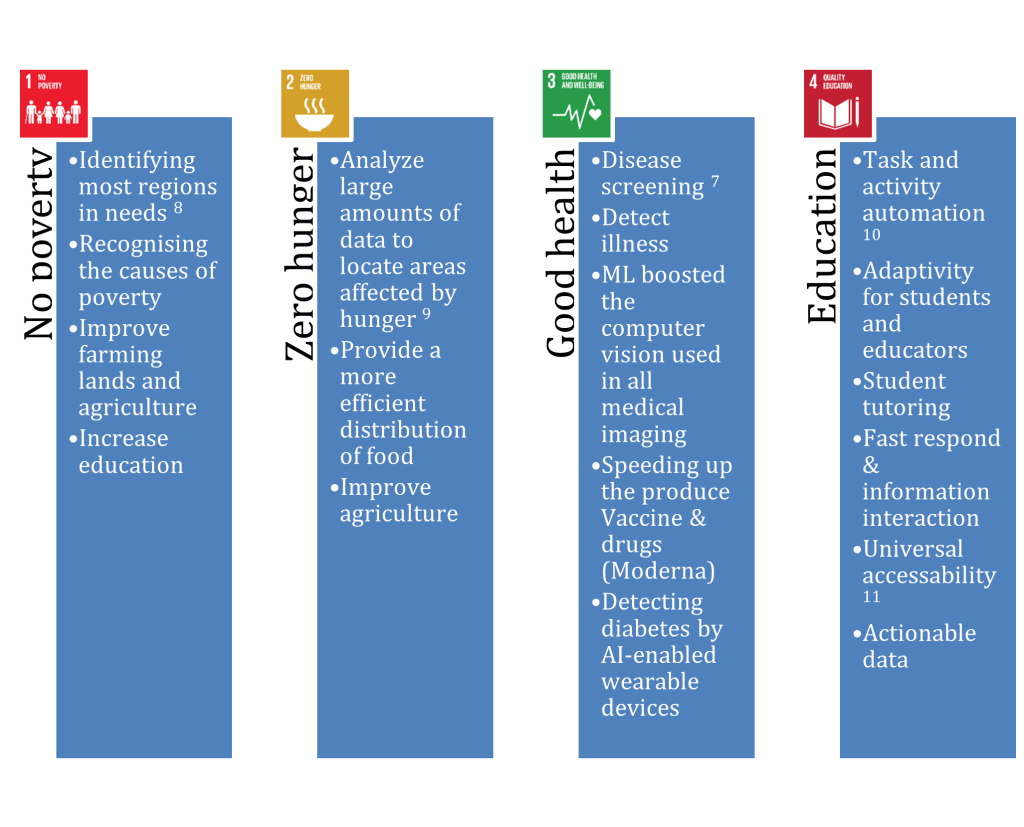
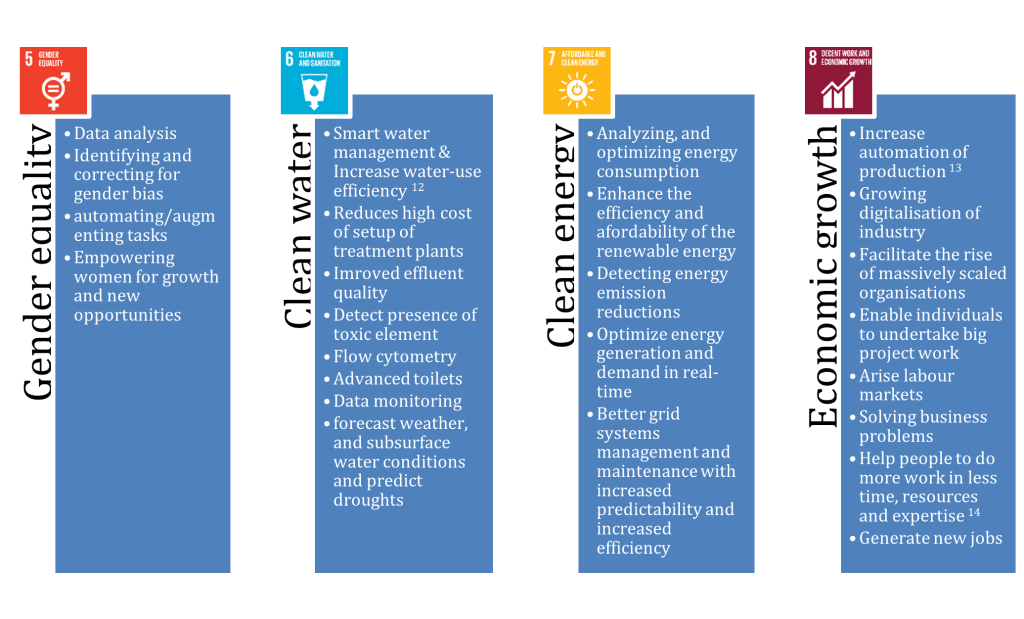
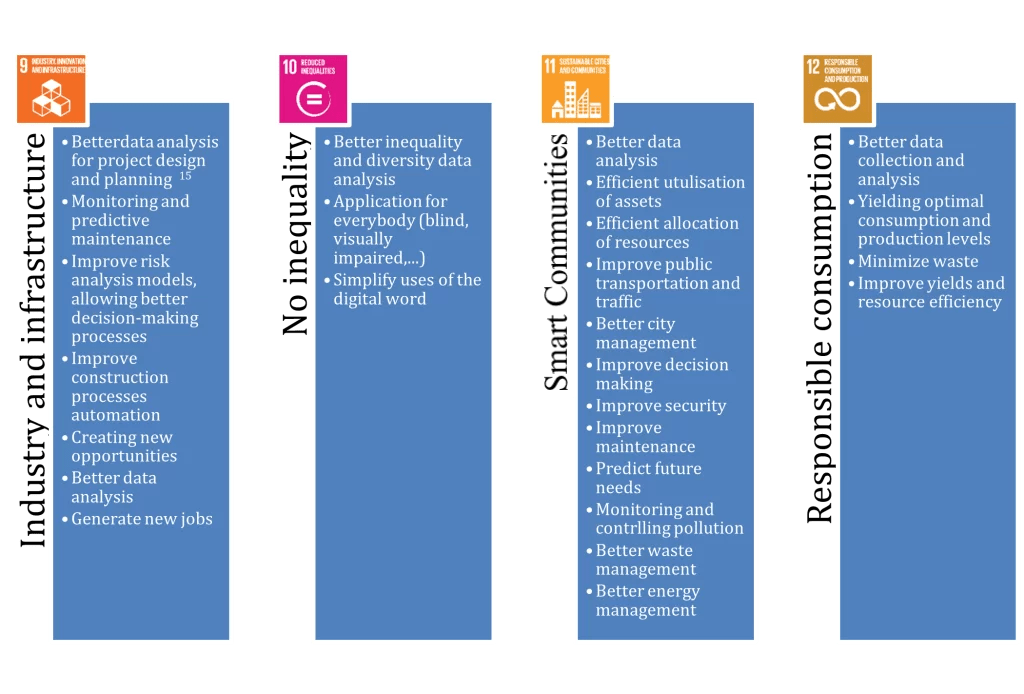
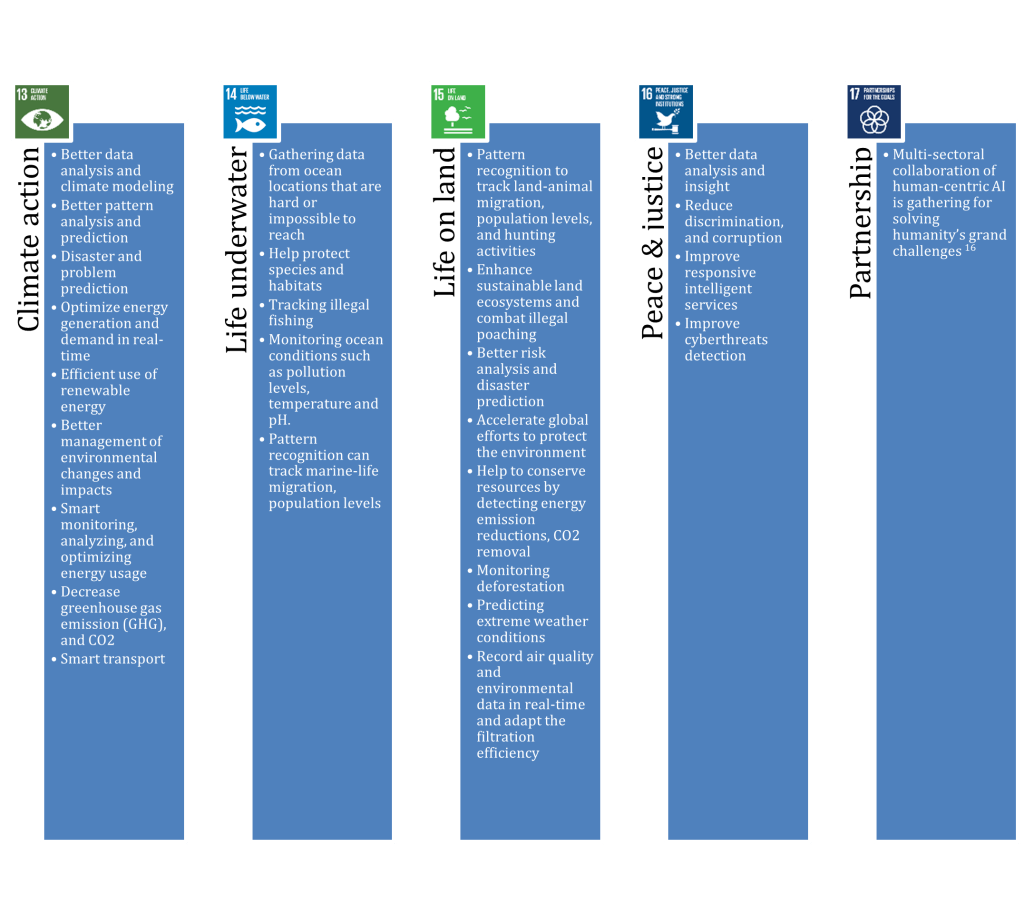
The Case For Machine Learning
However, we still need to be able to collect the relative data. This is a huge undertaking. We need to be able to discover which data is relative to sustainability, how to measure this, and thereby identify trends. Fedeli and Lüdeke-Freund tackle the problem of ‘inconsistent descriptions of SBM types’ by combining two approaches:
- Pattern theory, and
- Machine learning.
In their study, they develop and apply a method that supports the systematic automated identification and classification of Sustainable Business Model (SBM) patterns. They are able to discern patterns in the description of business models as they appear in corporate literature and websites. This information may also be found in official reports such as financial statements and sustainability reports. The identification and classification of business data allow us to discover trends. Big data analytics and ML make this kind of analysis possible.
Consequently, the authors developed the Systematic Pattern Recognition Intelligent Technology (SPRINT) system. SPRINT proposes natural language processing from static reporting to an ML-based, real-time classification system. The authors propose that better predictive analytics can be achieved using big data, ML models, and neural networks.
Ultimately, identifying patterns from business data will help us to rank business models against certain levels of sustainability. Thus, the strategies that best combine innovation with sustainable development will be recognised.
The Potential Dangers of AI
Aside from the many benefits, we must also consider the potential for misuse of AI and ML tools and techniques. They may be subject to both intentional and unintentional misuse and perhaps harm the very people they are supposed to help.
For instance, AI could harm developing countries or even established liberal democracies by manipulating outcomes to support nationalism, discrimination, or in ways that interfere with transparency in government.
In addition, there are many concerns about the lack of governance in the use of AI by ‘big tech’ companies. In particular, there is the threat of large-scale surveillance with virtually unlimited access to private data.
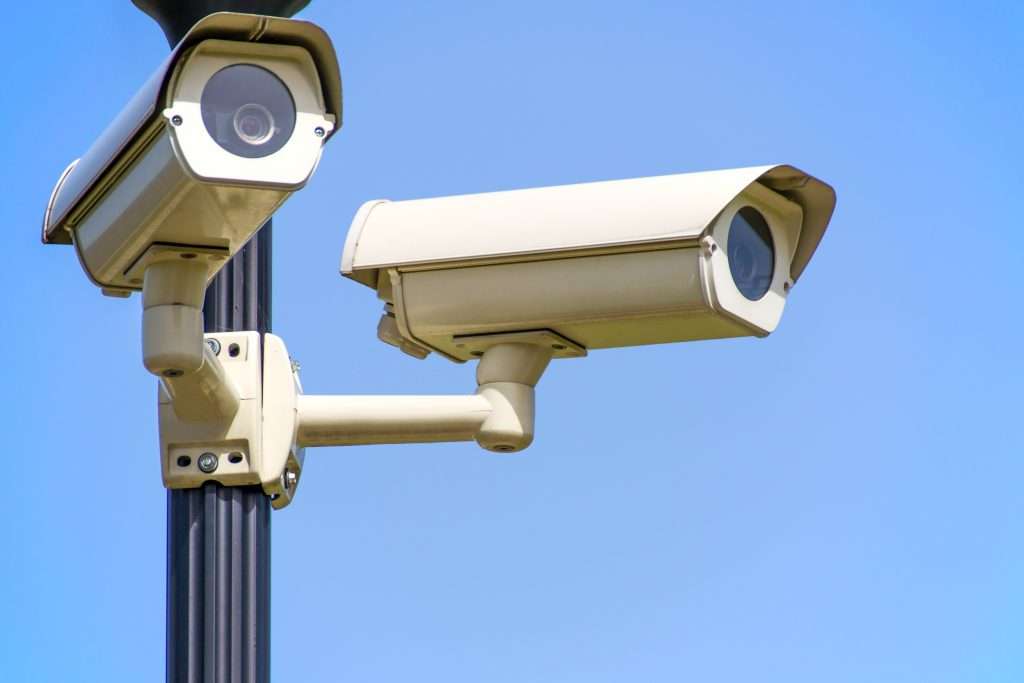
It’s Decision Time
Globally, there is an increased focus on building a sustainable world. But green practices alone won’t guarantee a sustainable future.
Without a doubt, the 17 Sustainable Development Goals (SDGs) and 169 targets in the UN’s 2030 Agenda represent the most important and comprehensive international agreement in history.
Moreover, ML provides the capabilities to measure outcomes on many levels (environmental, social, and political). Imagine being able to foresee the impact that public policies will have on the environment. Or, how effective strategies to change people’s habits will be in reducing their carbon footprint? What if you were able to evaluate the eco-friendliness of companies that are producing more sustainable products and services? Ones that are adopting fair trade practices with a green supply chain? This information becomes useful for a range of organisations and individuals.
Sadly, the main focus of Artificial Intelligence entrepreneurship to date has been much less focussed on sustainability than on generating profit.
We get to choose our roadmap
Of course, Artificial Intelligence is not a magical cure or a silver bullet. Nevertheless, it does offer a powerful tool that could be harnessed to achieve positive impacts. For that to become a reality, we need to facilitate the production of applications that serve the readily available data being provided by the scientific community.
Ultimately, we get to choose our technology roadmap:
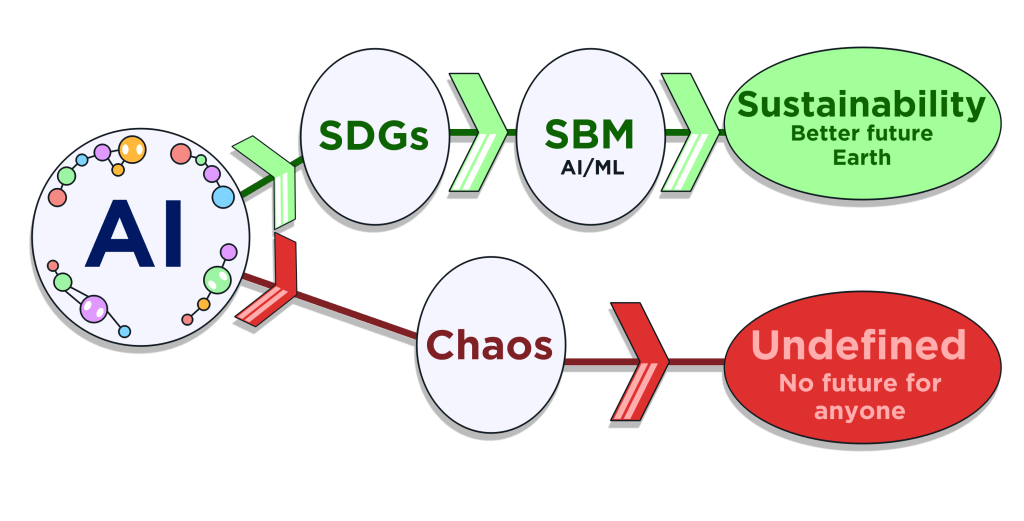
With proper oversight and collaboration, we can manage this ‘Fourth Industrial Revolution‘ for our benefit.
Correctly applied, Artificial Intelligence could tip the balance to a more sustainable planet. However, if we leave its development to chance, we may well miss that opportunity.
Conclusion
The alliance between Artificial Intelligence and a sustainable economy has only just begun. Civilization must somehow plot a path towards flourishing. Perhaps we can learn from the inherent circularity of the natural world and use this to live within the means of our finite planet.
AI provides unprecedented opportunities. It has a massive potential to target all the sustainability goals at the same time.
With Artificial Intelligence and Machine Learning, we can make meaningful progress toward a better world. We can stop the destruction of our ecosystem, we can address global inequality and injustice, and we can build a prosperous and thrivable future for all.
To find out more about the THRIVE Framework visit our website, and join the Thrive community for regular webinars, blogs and podcasts on sustainability issues.
Further Reading
The following articles provide examples of how artificial intelligence can be used for sustainability.
[1] https://www.ics.ie/news/ifip-thought-leader-to-present-to-united-nations/
[2] https://earth.org/data_visualization/ai-can-it-help-achieve-environmental-sustainable/
[3] https://www.valuer.ai/blog/how-can-ai-help-in-achieving-the-sustainable-development-goals
[4] https://www.weforum.org/agenda/2018/01/8-ways-ai-can-help-save-the-planet/
[5] https://www3.weforum.org/docs/Harnessing_Artificial_Intelligence_for_the_Earth_report_2018.pdf
[6] https://www.undp.org/blog/using-ai-help-achieve-sustainable-development-goals






















